This article contains affiliate links. We may earn a small commission if you purchase via these links.
Embedding laser rangefinder technology into binoculars is a costly undertaking.
It's why the best rangefinder binoculars are expensive.
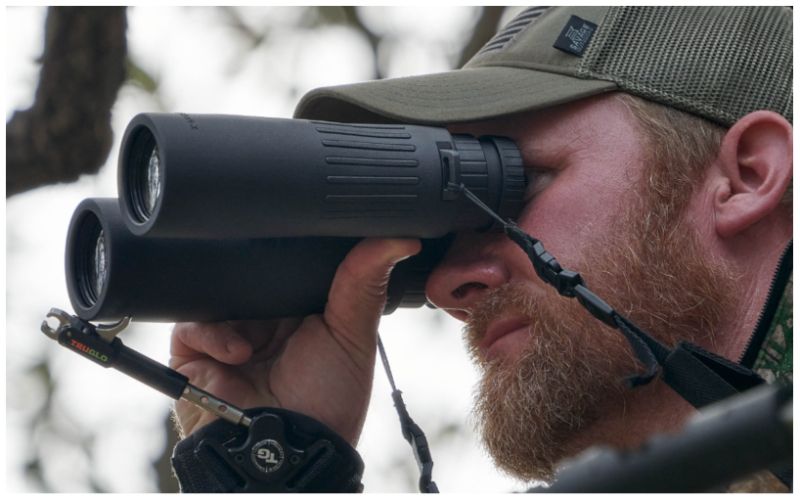
Considering this vital fact, I set a benchmark for excellent glass and accurate ranging as the standard.
Given the high costs, additional features are a must-have at this point.
Top Laser Rangefinder Binoculars of 2024
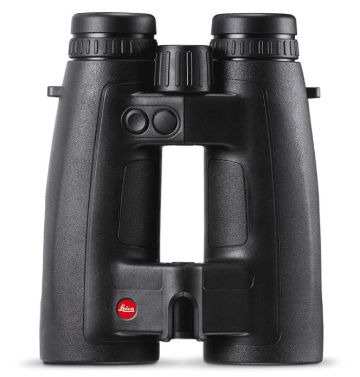
Lecia Geovid 10x42 3200.COM
Excellent optical quality
Applied Ballistics via Bluetooth
3200 yard range
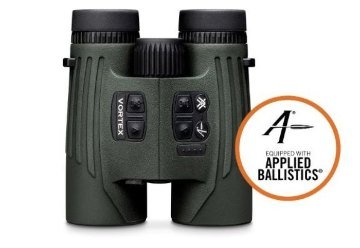
Vortex Fury HD 5000 AB
Applied Ballistics via Bluetooth
Tripod mountable
5000 yard range
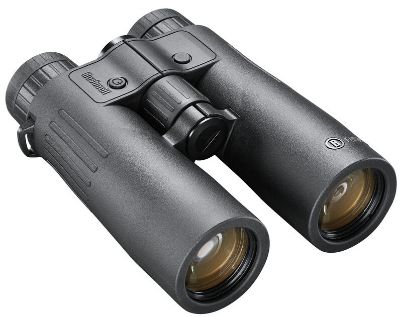
Bushnell Fusion X 10x42
ActivSync Display Technology
3 target modes
1760 yard range
Why Trust Us?
After hundreds of hours of hand-testing rangefinder binoculars in the field and at the range, and thousands more hours researching and writing about them, we feel we earn the title of experts when it comes to optics!
We purchase as many of the optics for our tests as possible, and run them through their paces to make sure they will perform at the range and in the field.
Our combined decades of experience from accurate distance measurements and hunting, to big game hunting and competitions has been integral in putting together this round-up of the best rangefinder binoculars for hunting.
Get the inside scoop on how we test optics here.
Rangefinder binoculars are not cheap. If you're looking to gain the convenience of having two optics in one unit, you better be able to pay up.
On that note, those looking to streamline their hunting setup will spring the cost for one of these units. The distance reach, advanced features, and the best glass will be recognized by an avid huntsman who can appreciate the married optics.
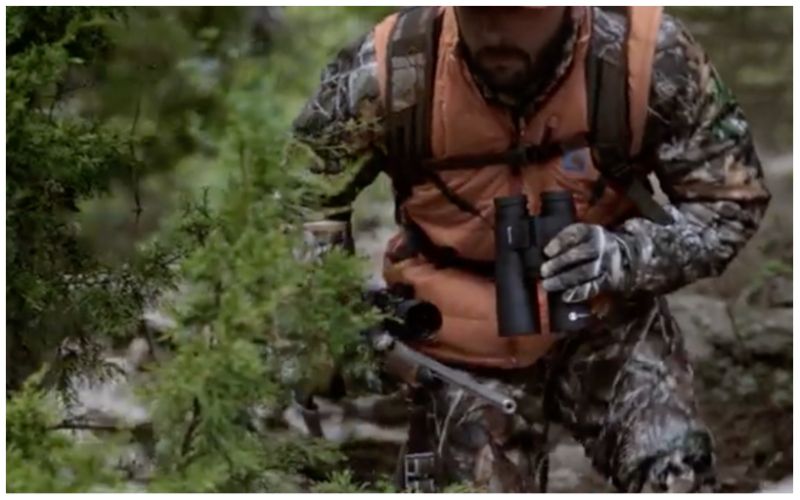
The concept behind rangefinder binoculars is brilliant, but it's all about execution. While the glass is always readily available, some conditions might prevent use of the rangefinder. Some features have practical value while others will never get touched.
With this in mind, I considered high-end manufacturers to guarantee flawless execution of ranging binos in low light, freezing temperatures, steep angles, and those with a bow. However, I also recommend an affordable rangefinder binocular for under $1000 for those with a tight budget.
| IMAGE | PRODUCT | DETAILS | |
|---|---|---|---|
 | Leica Geovid 10x42 3200.com |
| CHECK PRICE |
 | Vortex Fury HD 5000AB |
| CHECK PRICE |
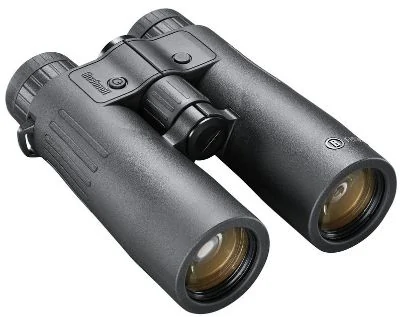 | Bushnell Fusion X 10x42 |
| CHECK PRICE |
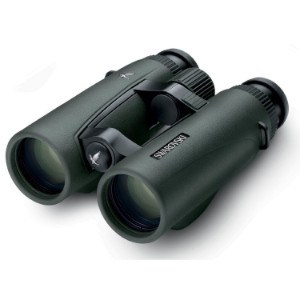 | Swarovski El Range 10X42 w/Field Pro |
| CHECK PRICE |
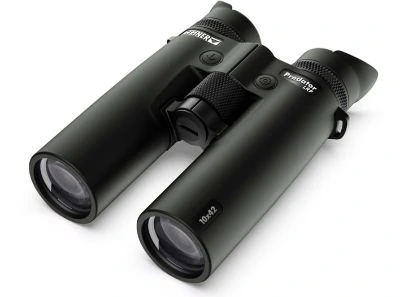 | Steiner Predator 10x42 LRF |
| CHECK PRICE |
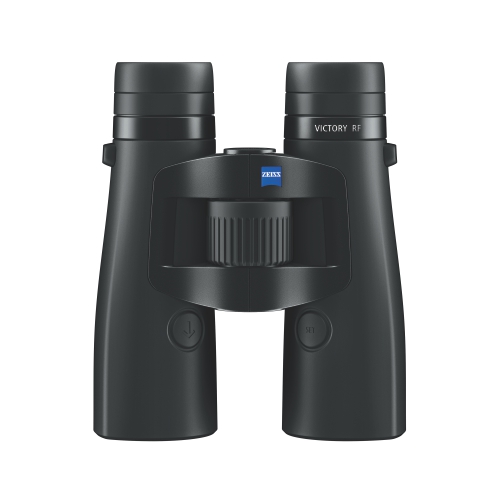 | Zeiss Victory RF 10X42 |
| CHECK PRICE |
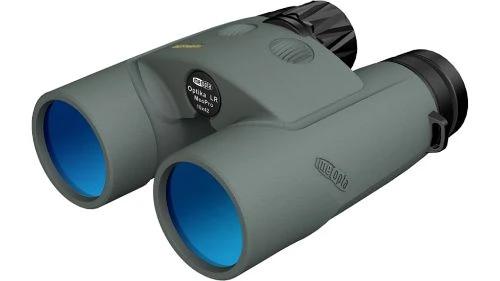 | Meopta Optika LR 10x42 HD |
| CHECK PRICE |
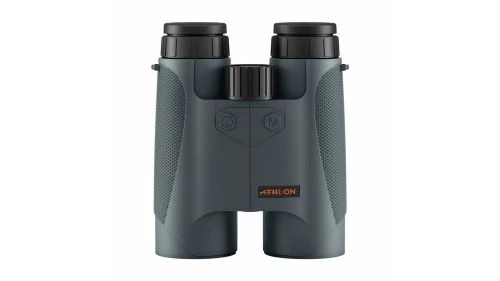 | Athlon Cronus G2 UHD 10x50 |
| CHECK PRICE |
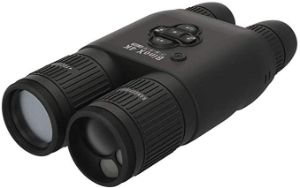 | ATN Binox 4K |
| CHECK PRICE |
The 9 Best Rangefinder Binoculars On The Market
1. Leica Geovid 10x42 3200.COM Rangefinder Binoculars - Best Overall
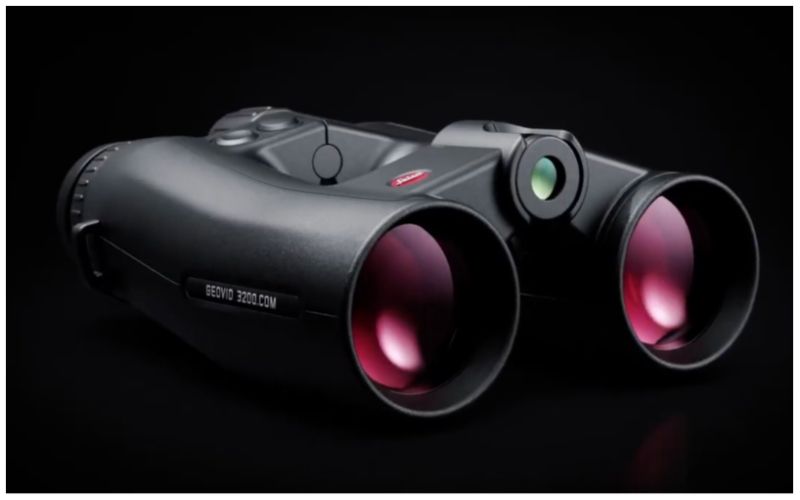
This particular Geovid sports Leica’s patented Pergo-Porro optical system. The sexy curves allow large hands to grip it comfortably, but that’s just a physical benefit. Optically, it’s every bit a Leica that you expect.
Pros:
- 3200 yards
- Bluetooth
- Applied Ballistics
- Kestrel pairing
- High-quality
Cons:
- Price
Being able to transfer custom profiles to your rangefinder is nothing new. Though what is new is doing it via Bluetooth without the micro-SD card. I like that the Geovid 3200.COM rangefinder is completely wireless and can connect to your smartphone, Apple watch, and a Kestrel. I'm not particularly tech-savvy, so having a direct connection to the app without further ado is a time-saver and convenience for me.
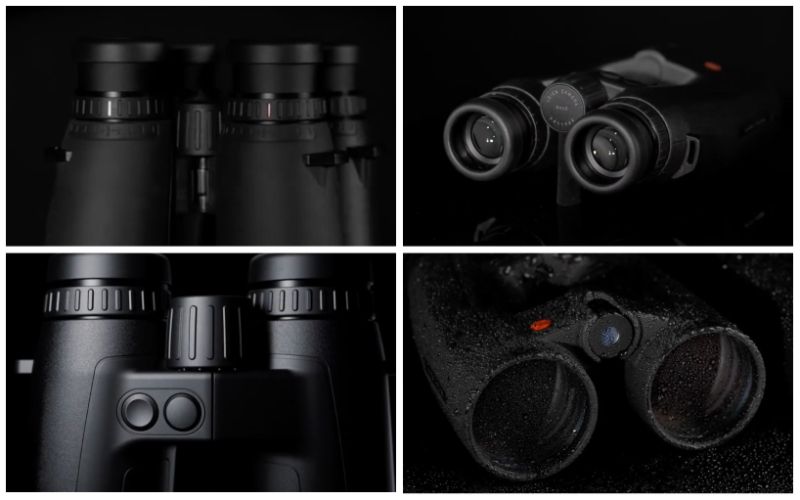
Obviously, the Kestrel is a major benefit for having ballistic solutions given the current conditions that it monitors. Plus, it can provide those solutions for as far out as you can range since the EHR is limited to 1200 yards and the Leica app and preloaded curves are limited to 800 yards.
So, I think it's awesome for rifle shooters who also want dope from their rangefinder. What about the bow hunter? You may as well get multiple applications out of it right?

I recommend EHR mode for bow hunters as it provides the equivalent horizontal range and angle necessary to determine the right pin for use. It also provides decimal readings up to 200 yards.
The 3200.com unit has a better processor, software, and ranging power over its current Leica alternatives. The only issue now is affording it.
2. Vortex Fury HD 5000 AB Rangefinding Binoculars - Best Value
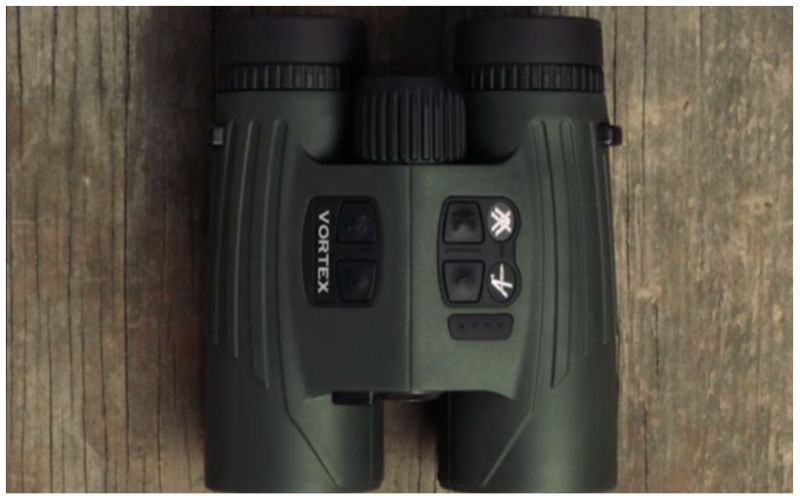
If you like what the Fury HD 5000 had to offer, wait until you find out what the Fury HD 5000 AB has to one-up it! With Bluetooth, applied ballistics, and 5000 yards of ranging, it has everything for half the price of its high-end competitors.
Pros:
- Price
- 5000 yards
- Applied Ballistics
- Bluetooth
- Tripod mount
Cons:
- Tech issues
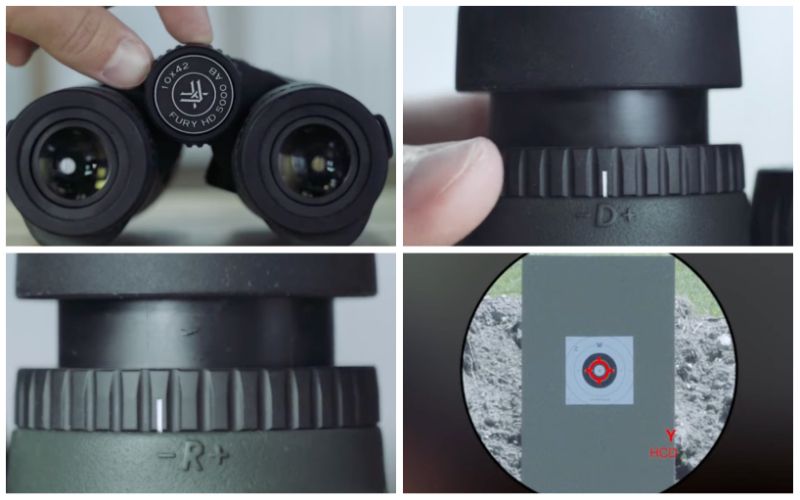
The 5000 AB has Applied Ballistics. You won’t need any SD cards because Vortex is following trend and going the Bluetooth direction. Pair it to the Fury HD app, pair it to a Garmin, or pair it to a Kestrel – I love that you can do it all.
I expect that with any modern piece of technology, there will always be syncing failures and/or related tech issues. The app itself has seen its own fair share of problems, but Vortex actively addresses bug fixes. Fortunately, I think issues are few and far between.
One of the best things about the Fury is that it's tripod mountable. The battery compartment is located on the underside of the body beneath the right barrel. This means the tripod receiver is free to play its part. For 5000 yards of ranging, it deserves to be mounted.
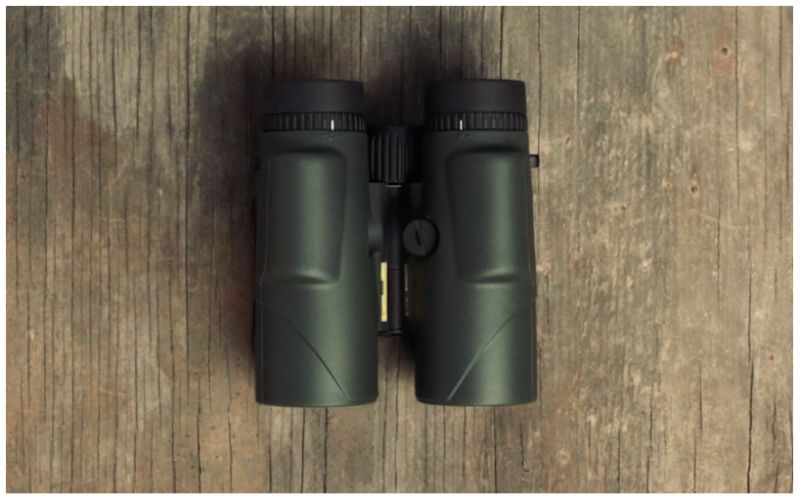
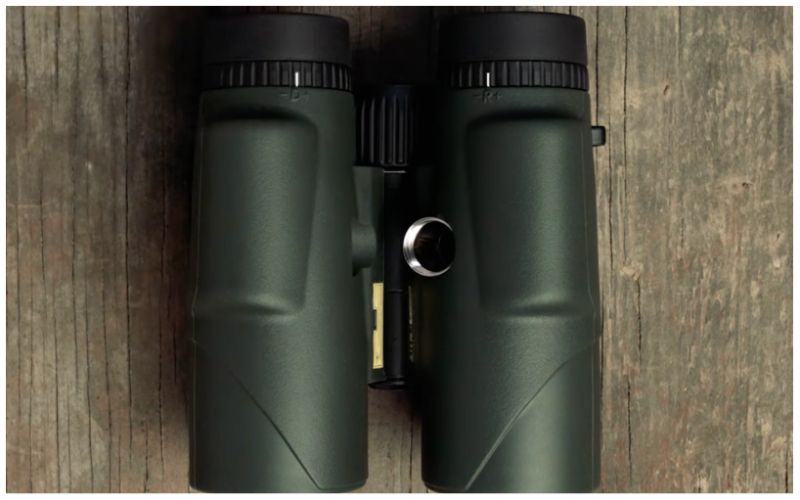
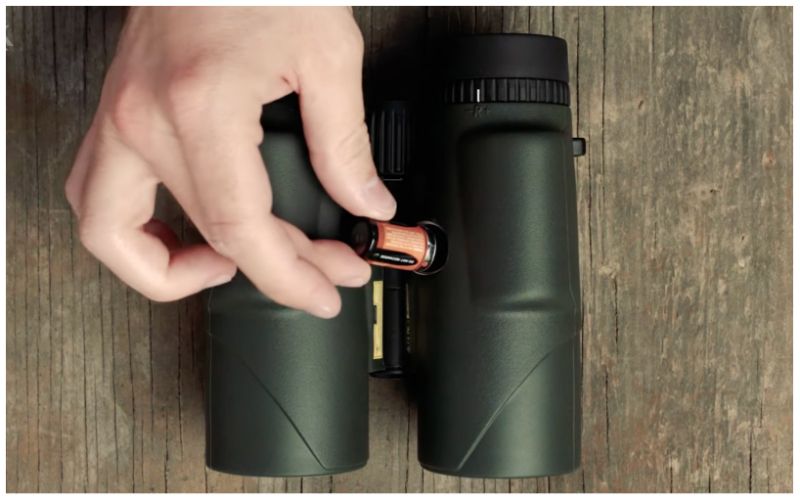
No one is ranging out to 5000 yards with a bow in hand, but it's still a viable rangefinding binocular for the bow hunter. I like that I can make things easy with the HCD mode that cuts out the ballistics and provides the angle and compensated range with decimal readouts.
In BALL Mode, there are three preloaded profiles, you can create custom profiles, and you can override everything with a Kestrel if you have one. You also have wind compensation. Readouts will provide corrections in MRAD or MOA. You can auto set ambient brightness or manually adjust it yourself.
There’s so much the Fury HD 5000 AB can do. Considering that I think the price point is low compared to similar alternatives, it's a value buy.
3. Bushnell Fusion X 10x42 – Best Under $1000
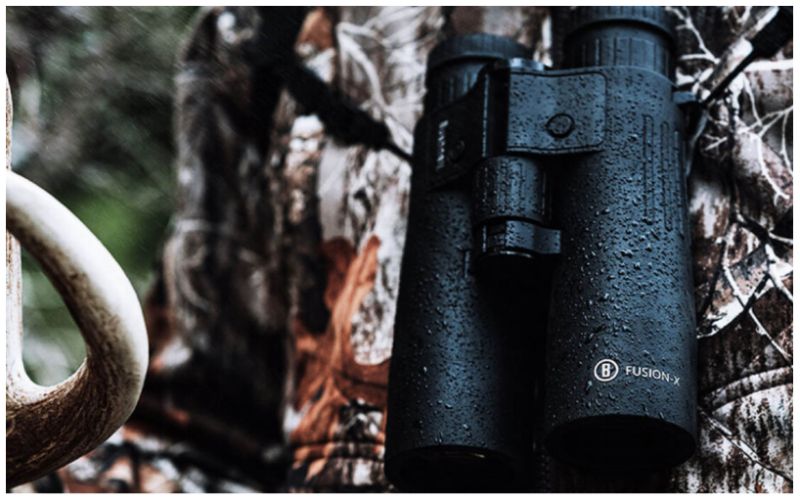
The Fusion X binoculars have new and improved features that have practical use in the field. Although it's still only a 1-mile (1760 yards) unit, it’s a rangefinder binocular under $1000 that puts it in the ballpark of affordability.
Pros:
- ActivSync Display
- Prism coatings
- 1760-yard range
- ARC modes
- 3 Target Modes
Cons:
- Not tripod mountable
The best feature about the Fusion X is the ActivSync Display technology. In bright conditions, the display will automatically revert to black as it automatically reverts to red illumination in the shade or dark. Each has four variable intensities. I'm impressed that Bushnell found a legitimate way to automatically prevent washed out displays or hard-to-read ones.
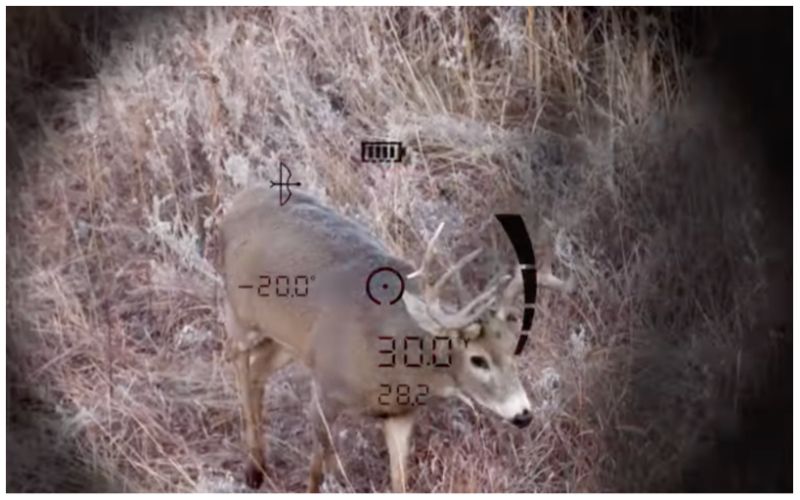
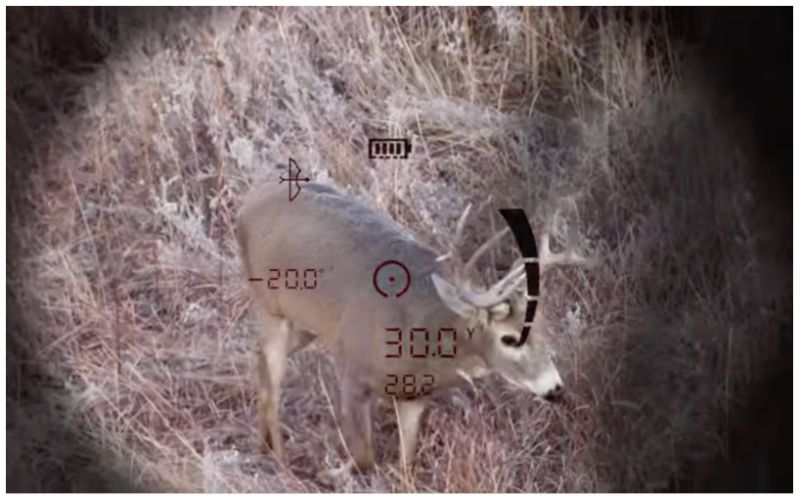
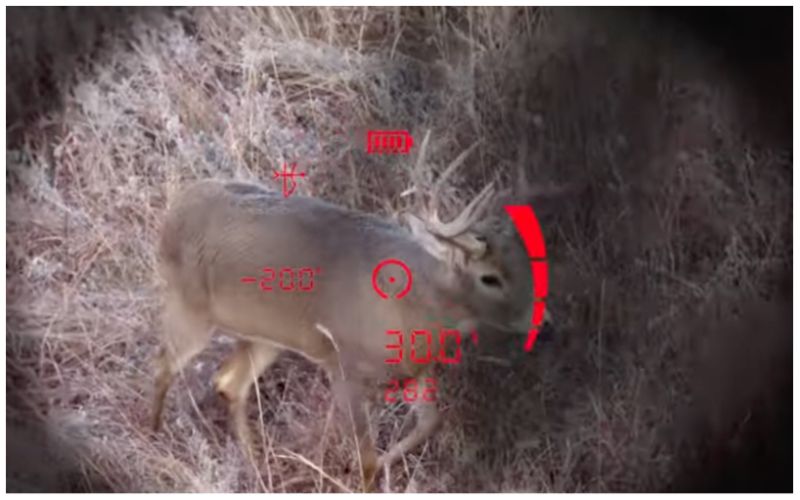
The optics are made with BK7 glass to form the roof prisms and this is perhaps one of the cost-saving features. Fortunately, Bushnell coated them with FMC, dielectric, and PC3 coatings to improve reflectivity, light transmission, and resolution. To protect the objectives and enhance visibility in snow, rain, and fog is an exterior Exo-Barrier Lens coating.
I'd say that it still has low ranging distances for today's standard with 900 yards on trees and 700 yards on deer and flags (golf). Even so, it has the must-haves with three target modes: Standard (up to 1800 yards), Brush (Second), and Bullseye (First). Scan can be activated in each mode.
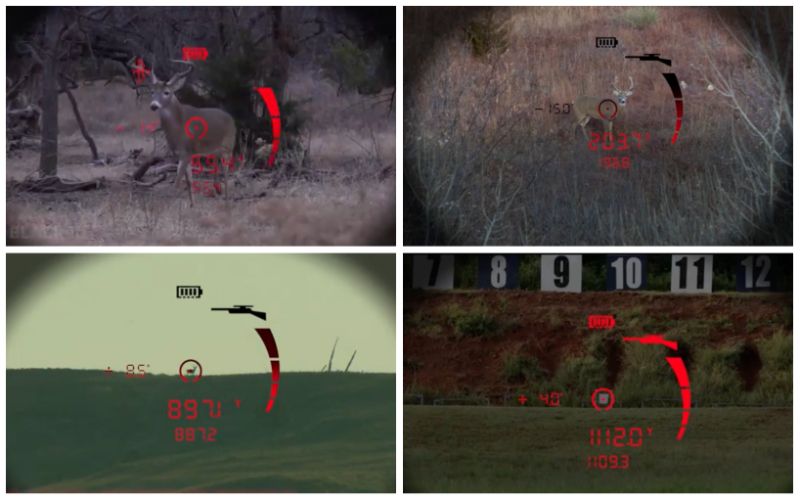
ARC (Angle Range Compensation) offers three modes: Regular (LOS), Bow, and Rifle with the latter two offering angle compensated distances and the angle of incline/decline. In Rifle mode, eight preloaded caliber and load calibrations allow for auto calculations of holdover in inches, centimeters, MIL, or MOA.
The Fusion X has three reticles to choose from: circle, dot, and circle with dot. Though I know it can’t be tripod mounted, most ranging binos can't either. Backed by the Lifetime Ironclad Warranty and at such a low price, the Fusion X stands to be the best ranging binos for the money.
4. Swarovski El Range 10X42 w/Field Pro Rangefinder Binoculars
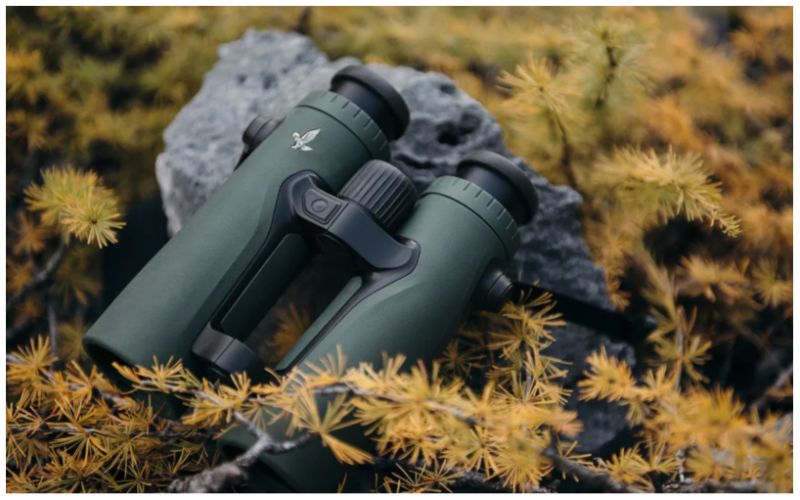
As the most expensive unit in this lineup, the Swarovski is definitely something to behold. While everything about it is swank and sexy, the price - not so much. I decided its price point makes it harder to rank against alternatives, but it's the quality that earns it a place with me.
Pros:
- Excellent glass
- Locking features
- 2200-yards
- Submerisble
- Tripod mountable
Cons:
- Price
Swarovski has always been an authority in the optics market, and with the El Range binoculars, they certainly meet the standard of expectations. While it doesn't offer ballistic data, it's outfitted with SwaroAim for angle compensated distances.
As you and I can expect from Swarovski, the optics are far beyond average. It has everything you need to make time out in the hunt worth it from its excellent resolution in lowlight to its edge-to-edge sharpness of the 330' FOV. It has SwaroBright, an integrated diopter, and a locking center focus.
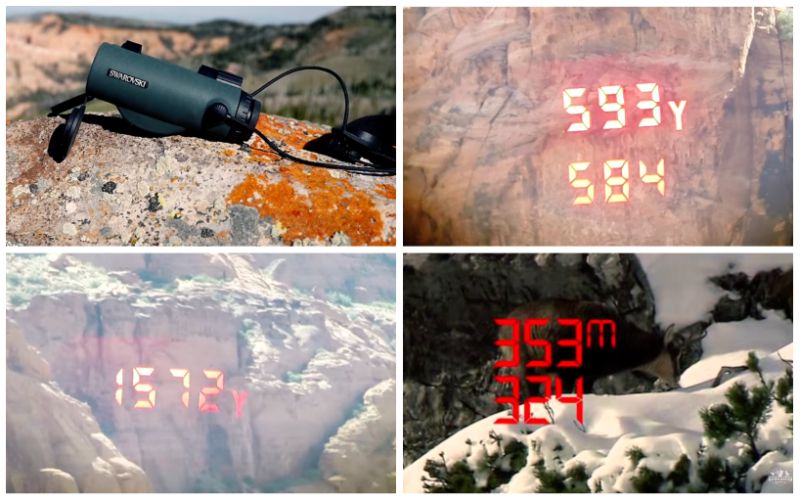
I'm really happy to see that it can be mounted to a tripod. Many ranging binos cannot be, so this is a point in its favor. Of course, it's completely waterproof to the point of submersion.
The El Range doesn't have the additional features that alternatives have at half the cost. This is a legitimate concern considering its price point and the fact the laser engine maxes out at 2200 yards which in today's competitive market is really good but average.
However, it has what I expect from Swarovski - meticulous attention to detail. From the locking features to the 1.2 x 0.5 MRAD (approx.) beam divergence (tough to beat!) and 5 manual and auto-brightness settings, the El Range offers high-end performance with solid ranging abilities.
5. Steiner Predator 10x42 LRF – Best Military Grade
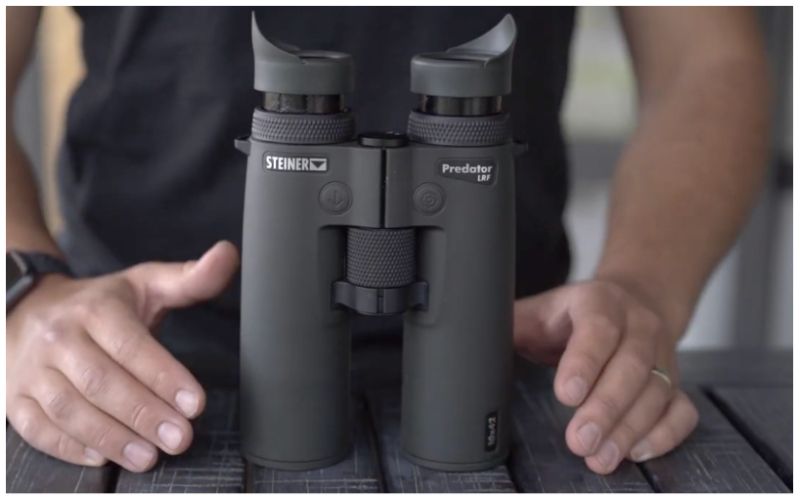
The Steiner Predator has been made with military grade optics that civilians and hunters can now depend on in the field. It didn't take long for it to break into the slim and competitive market. I'd bet my money that it's a hit because it’s simple, effective, and made in Germany.
Pros:
- 1969-yard range
- Angle compensation
- Various measuring modes
- Fast-close-focus
- Made in Germany
Cons:
- No ballistics software
The maximum ranging distance for the Predator LRF is 1969 yards (1800m) with a minimum distance of 5.5 yards (5m). I will point out that it's not as long-ranging as its competitors in the same field, but it has a more attractive price point.
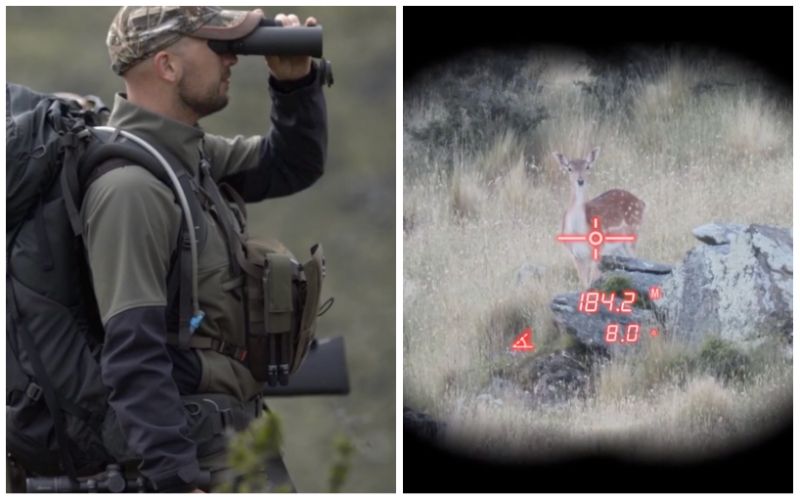
Like all ranging binos, it provides LOS and angle compensation modes just as I expect. Unlike other high-end units, it does not have preloaded ballistics or connectivity to ballistic software for holdover solutions. The Predator LRF has Standard, Rain, Long-Distance (Second), Short-Distance (First), and Scan modes to filter its ranging capabilities for the terrain and conditions.
The Steiner Predator has a Fast-Close-Focus system that requires minimal action to acquire sharp focus for targets at various distances. It has their secret high-definition Predator Diamond Coating technology. Interestingly, the LRF model has a wider FOV of 344 ft than the non-LRF Predator 10x42.
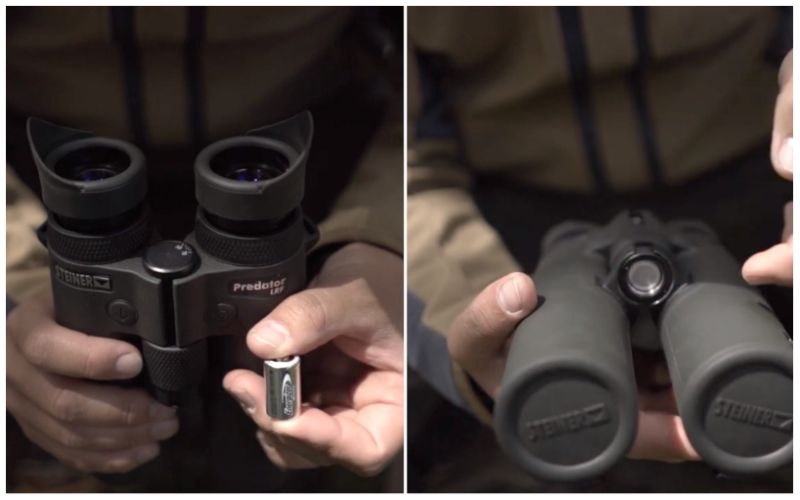
I'm disappointed given that it's in the big range at 8.27 x 5.5 x 2.2” weighing in at 35.8 oz, and it is not tripod adaptable.
Overall, other than the fact that I like the easy-to-use, German-made, military-grade binoculars, I like it even more knowing that it comes with the Steiner Heritage Lifetime Warranty. It’s comparable to other industry-best warranties in that it’s covered for life, transferable, and no warranty or receipt is required. Electronic components are warrantied for three years.
6. Zeiss Victory RF 10x42 Rangefinder Binoculars
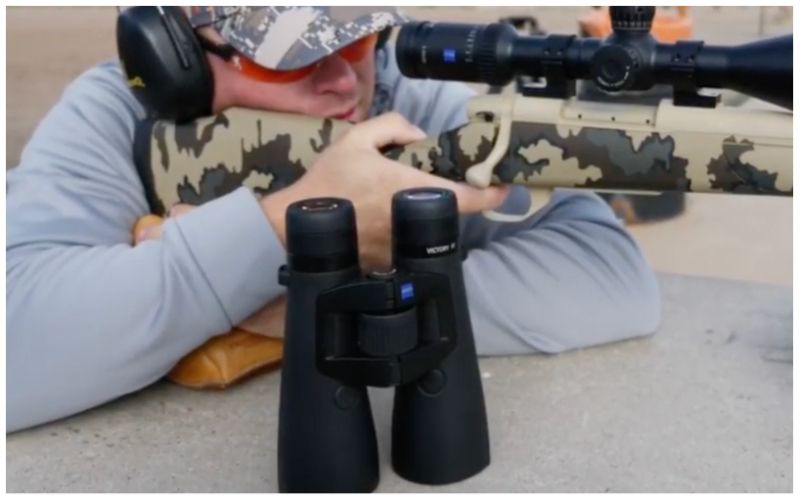
There are few manufacturers that can get away with selling $3000+ ranging binos. Zeiss is one of them with their Victory 10x42 RF. Beyond talking about the grandeur of German glass, at least it gets out to 2300 meters (2515 yards) which is more than some comparable high-end alternatives.
Pros:
- 2515 yards
- Bluetooth
- Ballistic solutions (via app)
- Angle compensation
- Oversized focus wheel
Cons:
- Price
I can confidently say that the Victory RF wouldn't be one of the most advanced optics available if it didn't have Bluetooth. Connect it to the Zeiss app to input various factors and you have personalized ballistic data to your setup.
Like many high-end and costly rangefinder binoculars, it can display an angle compensated distance and holdover solutions in inches, cm, MOA, or MIL and the number of clicks of needed.
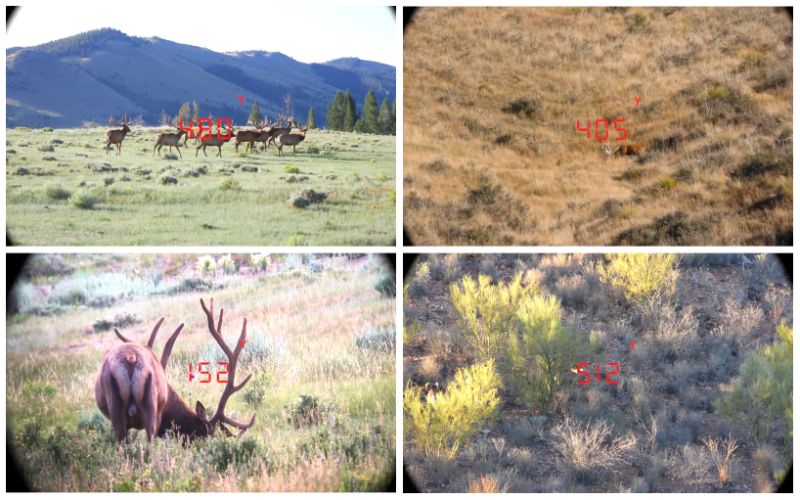
I value ergonomic optics, so the convenience and comfort is evident with its one-hand operation (left or right) and its oversized focusing wheel. Inherently, it does not have a receiver for tripod mounting. However, Outdoorsmans made a fix for that or you can figure out a rig yourself.
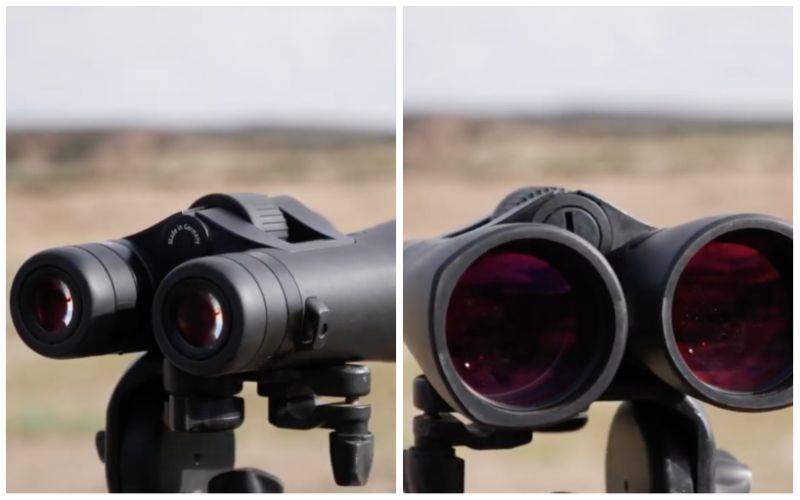
The Victory RF has a great 354' FOV, and I want to point out its Abbe-Koenig prisms - this is likely where a lot of the cost comes from!
Many positive things have been said about the user-friendly interface of the Zeiss Hunting App. I recommend downloading it otherwise you wouldn’t be using the Victory RF to its maximum potential. However, like many superb optics, it's not in the realm of affordability. This sleek and highly-intuitive rangefinder will set you back a pretty Benjamin plus some.
7. Meopta Optika LR 10x42 – Best Mid-Range Binoculars
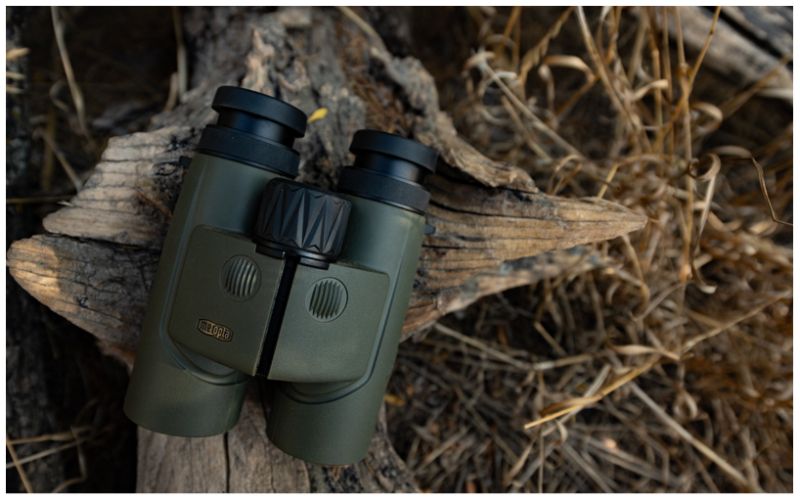
Not every manufacturer has rangefinding binoculars, so if one can provide it whereas another cannot, it’s a big advantage for the company. Meopta plunges into this market with the Optika LR 10x42. With their stunning optical performance, it’s easily one of the best mid-range units available.
Pros:
- 2600-yard range
- Fluoride glass
- Angle compensation
- Magnesium chassis
- Tripod mounting
Cons:
- Price
I think the Meopta LR is in the reasonably affordable range for these kinds of optics, between $1000-$2000, but it's still costly considering it doesn't have applied ballistics. Still, the 2600-yard ranging is excellent, but its real performance comes back to the glass.
Meopta is well known for their Schott glass and are uniformly compared to Swarovski. I think it performs excellently in eliminating chromatic aberration and delivering sharp resolution in low light. With fluoride, glass performance is superior to all alternatives at the same price point.
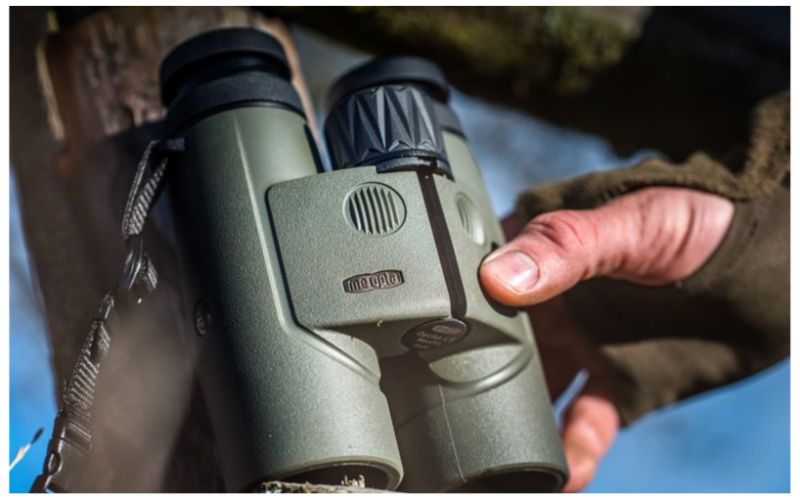
Made with a magnesium alloy chassis, having been O-ring saled and gas-purged, and weighing in at 32.6 oz, it’s much like other high-end ranging binoculars. But I will point out that it has a tripod receiver for mounting. Believe it or not, not all ranging binoculars can mount up.
As a rangefinder, it offers 2600 yards of reach on reflective targets and is accurate to +/-1-yard to 1000 yards and +/-2 yards to max. The OLED display can be adjusted for brightness. It features Auto, Brush, and Scan modes, and of course, you can toggle between meters or yards - your preference.
Considering that the Swarovski El Range offers up 2200 and the Zeiss with 2500, the Optika LR is a worthwhile buy with its glass and 2600-yard reach. Though it’s no Swarovski, it doesn’t cost like one either.
8. Athlon Cronus UHD 10x50 – Best 10x50
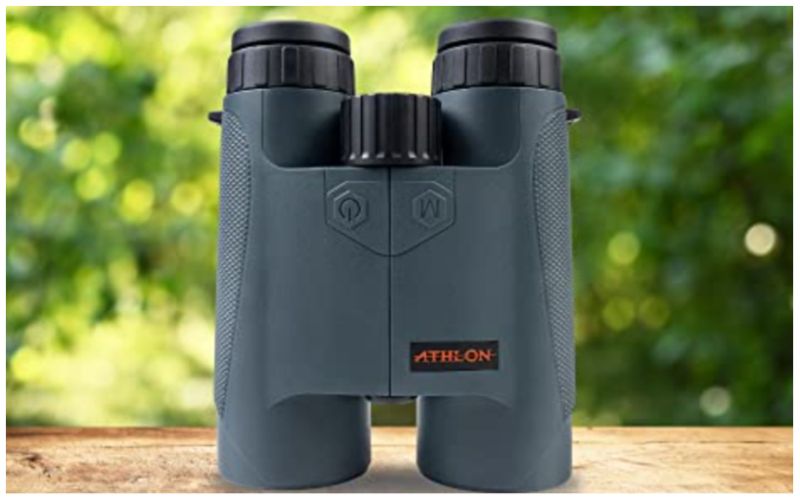
Overall, the Cronus UHD is a mid-range rangefinding binocular with more than the basics. It might not have every feature available, but it fulfills practical and budget needs. The Cronus embodies the very best in optical performance that Athlon can provide.
Pros:
- 2000 yards
- LED display
- ED glass
- Magnesium chassis
- Long eye relief
Cons:
- Heavy
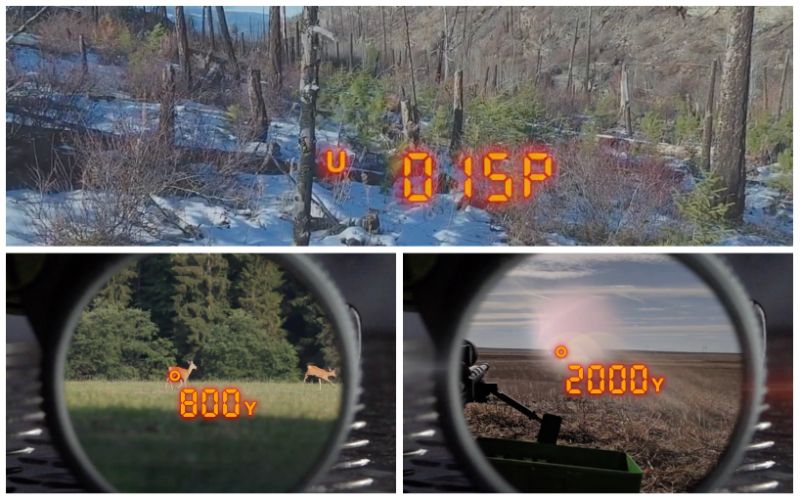
The ranging reach of the Cronus is 2000 yards on reflective targets and 800 yards on deer. Given that the 2000-yard distance is half that of alternatives, 800 yards is still effective for deer and elk hunters, though from experience out West, it's limited.
Helping to ensure you acquire accurate measurements in lowlight conditions, the Cronus has a 10x50 configuration. The larger objectives will help to transmit more light to the eyes. This is a credible thought process because Athlon put everything they had into its optical performance.
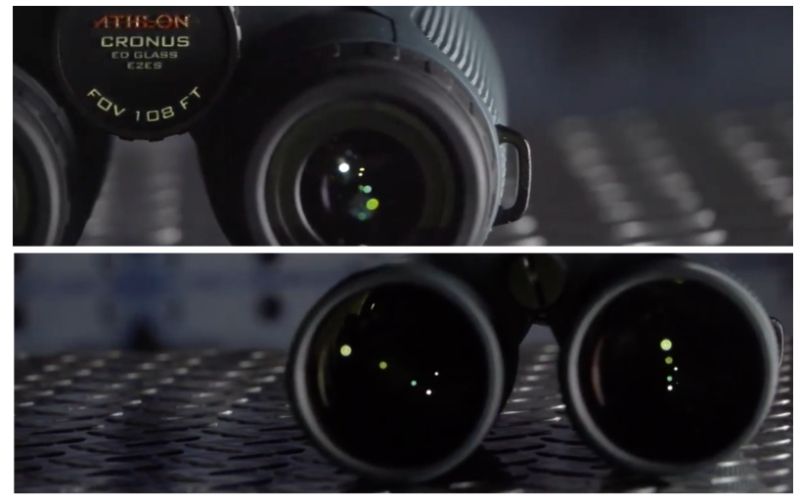
The ED glass has Athlon’s Edge 2 Edge Sharpness System (E2ES), Enhanced Spectral Prism Dielectric coatings (ESP), and phase-corrected BaK-4 prisms. The objectives were also treated with their Xtra Protective Layer coating.
When it comes to the specs, I like the long eye relief of 19.3 mm and the wide FOV of 338' for a 10x50. I judge it to be beefy at 38 oz, but most ranging bino combos are not lightweight to begin with. At least the chassis was made from magnesium alloy, so it’s tough and long-lasting.
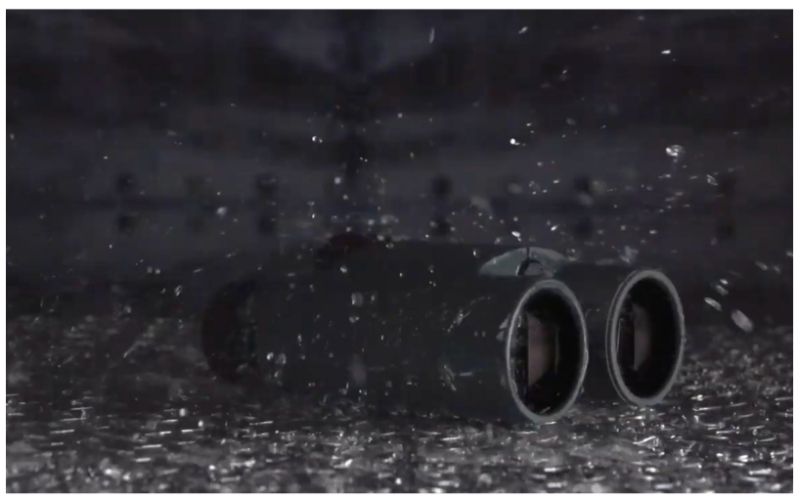
The ranging engine supports Auto, Flag, and Deer modes, LOS, vertical, and angle compensation modes. The LED display has adjustable brightness.
Though not comparable to high-end ranging binoculars with the works, one must give credit where credit is due. The Cronus UHD is welcome competition to this small market. I recognize it as appealing but without going overkill in features or cost.
9. ATN Binox 4K 4-16X Rangefinder Binoculars - Best Night Vision
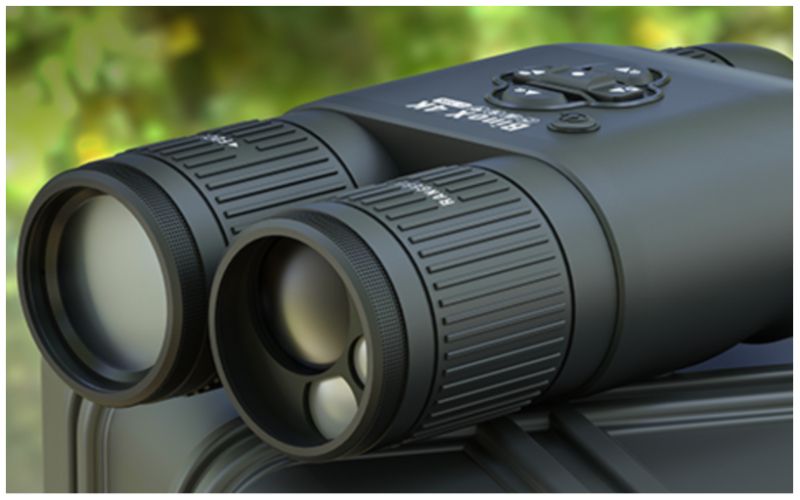
The Binox 4K is ATN's digital night vision rangefinder binoculars. There's a lot to gain with the Binox but my favorite features include its dual day and night use, lasing engine, and it's priced below $1000.
Pros:
- Day/night use
- Laser rangefinder
- Digital features
- Ultra HD sensor
- BIX feature
Cons:
- Heavy
The Binox isn't your passive night vision device but a digital unit. It's powered by an internal lithium-ion battery that lasts for over 15 hours before it needs to be recharged. Running the whole operation is the M4 M265 sensor that delivers 600 lp/mm system resolution with display resolution of 1280x720. During the day you have color vision and a black/white (monochrome) display with very good detail at night.
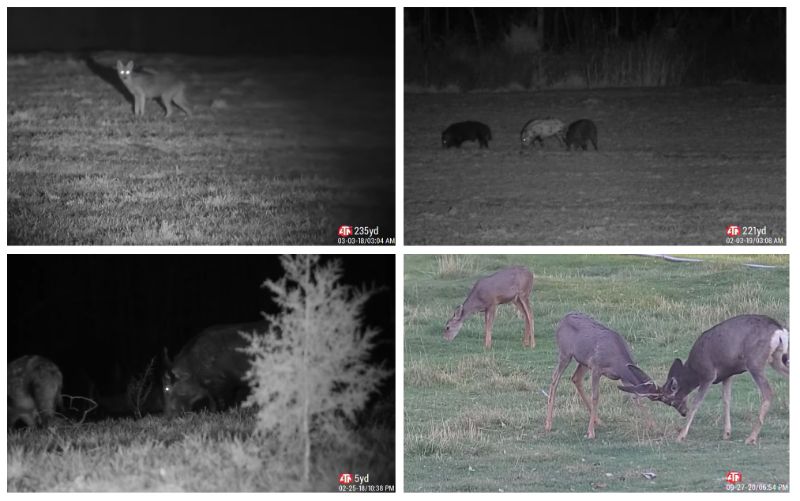
When it comes to the lasing engine, it's on the short end for a rangefinder, but it offers 5-1000-yard ranging performance. The catch about it is that you're essentially using a system where you take two measurements - top and bottom of the target. It's like using a digital stadiametric rangefinder since you should have an idea of the height of the target.
Since it's a digital device at heart, I find a lot of value and convenience in on-board video recording capabilities. It has dual stream video, so you can stream it live to another device. It also has WiFi, E-Compass, E-Accelerometer, and more. I really like the BIX data exchange technology if you're using an ATN scope, because holdovers are immediately displayed on the scope.
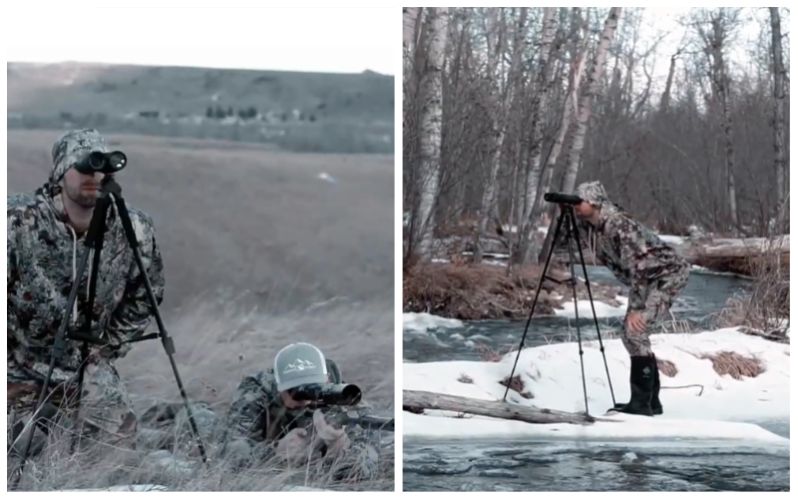
The drawback is that they're heavy at 40oz and bulky at 9.4 x 5 x 2.6" in size. I recommend tripod mounting the Binox especially if you're using the digital magnification, video recording, or glassing for long periods of time.
Obviously, it's stands apart from the rest in my lineup since it's ready for use in nighttime hunts for hogs, coyotes, foxes, and more.
What to Look for in a Quality Rangefinding Binocular
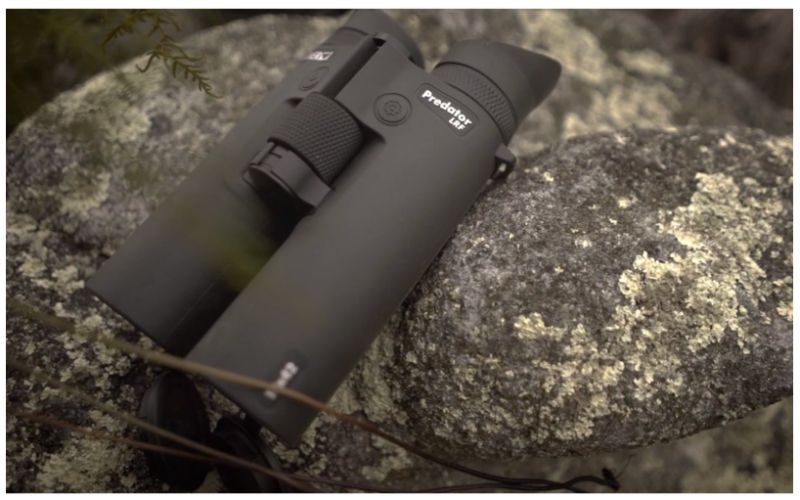
When you have the marriage of two optical systems combined into one, you always want the quality to come from its fundamental components.
Great glass and a great ranging engine equates to a solid rangefinder binocular.
Sure, the ranging engine might range out at 5,000 yards, but can the glass keep up to resolve with detail what you're looking at?
These units are expensive, so I'll start with budget.
Budget
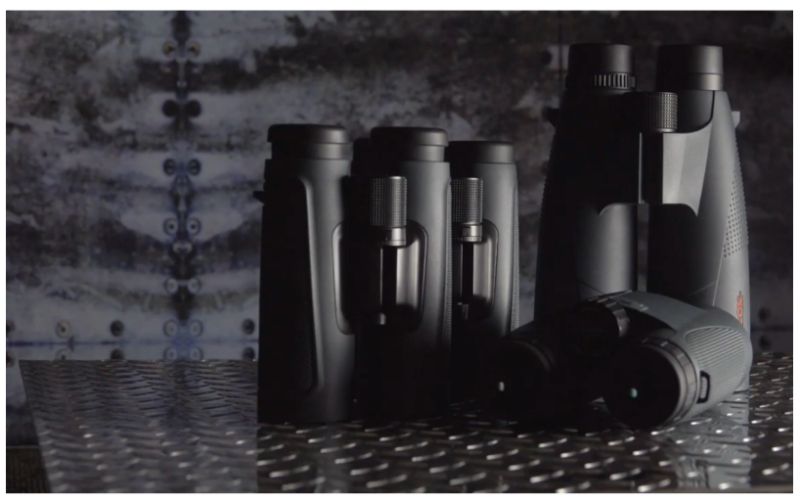
There's a healthy balance in this price range, even though it's a high one. They range from $1000 to $4000. High-end manufacturers include Leica, Zeiss, and Swarovski and they can guarantee glass quality and laser accuracy.
Mid-range units encompass the $1000-$2500 price range. There's a lot of variety here as some may offer long-ranging reach with applied ballistics while others will not.
To date, there are too few ranging binoculars for under $1000.
| Binocular | Cost | Features |
|---|---|---|
| Leica Geovid 3200.com | Under $3000 | Long 3200 yard range, No SD card needed, Perger-Porro optical system, Kestrel Pairing. |
| Vortex Fury HD 5000AB | Under $1500 | Excellent 5000 yard range, Tripod Mountable, Bluetooth, Wind Modes. |
| Bushnell Fusion X | Under $1000 | Angle Compensation & Holdovers, Auto Red Illumination & Black Displays, Waterproof & Fogproof, 1760 yard range |
| Swarovski EL Range | Under $3500 | Tripod Adaptable, Excellent glass quality, Submersible, 1500 yard range |
| Steiner Predator LRF | Under $2000 | Angle Compensation, Military Grade Toughness, 1969 yard range |
| Zeiss Victory RF | Under $4000 | Ranges to 2515 yards, Bluetooth Connectivity, Angle Compensated Distance & Holdover |
| Meopta Optika LR | Under $1500 | Angle Compensation, OLED Display, Waterproof & Fogproof, 2600-yard range |
| Athlon Cronus UHD | Under $1500 | Angle Compensation, OLED Display, Waterproof & Fogproof, 2000-yard range. |
| ATN Binox 4K | Under $1000 | Digital Day & Night Vision, WiFi/Bluetooth Connectivity, Dual Stream Video, Rechargeable battery, 4-16x magnification, 1000-yard range. |
Magnification & Objectives (Configuration)
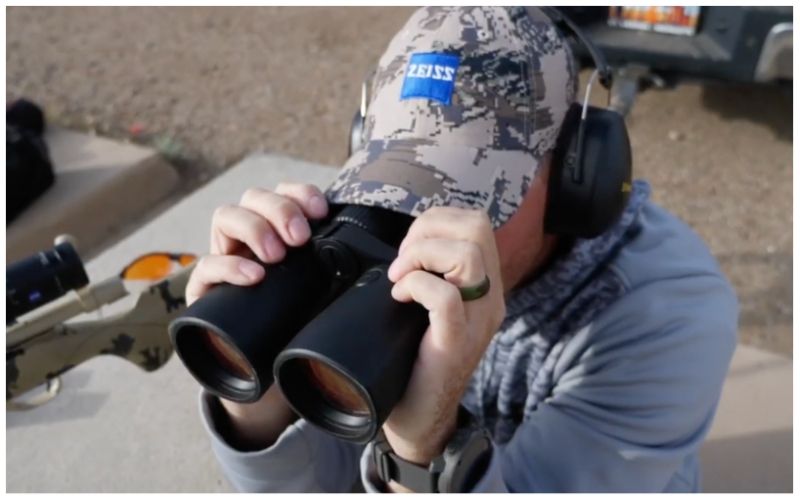
On average, most rangefinder binoculars will have the 10x magnification and 42 mm objective lens diameter configuration. This is right within the realm of handheld ease-of-use with the desirable specs and benefits of this configuration.
Since these are costly to manufacture, usually only the high-end manufacturers may have various configurations in their rangefinding binocular series. Most of the time, it will only be your standard 10x42 that you will see.
| Binocular | Magnification (Power) | Objective Lens Size (Aperture) |
|---|---|---|
| Leica Geovid 3200.com | 10x | 42 mm |
| Vortex Fury HD 5000AB | 10x | 42 mm |
| Bushnell Fusion X | 10x | 42 mm |
| Swarovski EL Range | 10x | 42 mm |
| Steiner Predator LRF | 10x | 42 mm |
| Zeiss Victory RF | 10x | 42 mm |
| Meopta Optika LR | 10x | 42 mm |
| Athlon Cronus UHD | 10x | 50 mm |
| ATN Binox 4K | 4-16x | 40 mm |
Rangefinder Performance
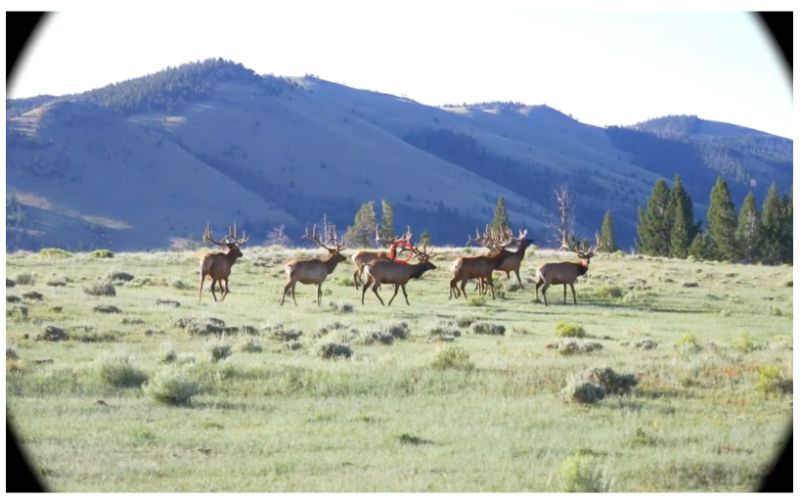
In general, the first rangefinding distance disclosed is the maximum reflectivity distance. This is often an extravagant distance, but some rangefinders are capable of delivering. However, it's the soft and medium-range distances that many hunters actually need to know.
Trees will often have a slightly higher distance than deer, and calculating actual performance is somewhere around the 75% of the advertised maximum distance. For deer, it's about 45-75%.
Since deer and elk are small, the beam divergence has a lot to do with how effectively you can get an accurate distance. It isn't always disclosed by the manufacturer, but it can be a great indication of rangefinder performance.
For more about how rangefinders work, check out our comprehensive guide on it.
| Binocular | Min. Distance | Max. Distance | Deer Distance |
|---|---|---|---|
| Leica Geovid 3200.com | 10 yards | 3200 yards | 2000 yards* |
| Vortex Fury HD 5000AB | 5 yards | 5000 yards | 1600 yards |
| Bushnell Fusion X | 5 yards | 1760 yards | 700 yards |
| Swarovski EL Range | 10 yards | 2200 yards | 1200 yards |
| Steiner Predator LRF | 5.5 yards | 1969 yards | 1300 yards* |
| Zeiss Victory RF | 11 yards | 2515 yards | 1200 yards |
| Meopta Optika LR | 5 yards | 2600 yards | 2000 yards* |
| Athlon Cronus UHD | 5 yards | 2600 yards | 800 yards |
| ATN Binox 4K | 5 yards | 1000 yards | Unknown |
*Not disclosed: estimate
Size, Weight & Tripod Adaptability
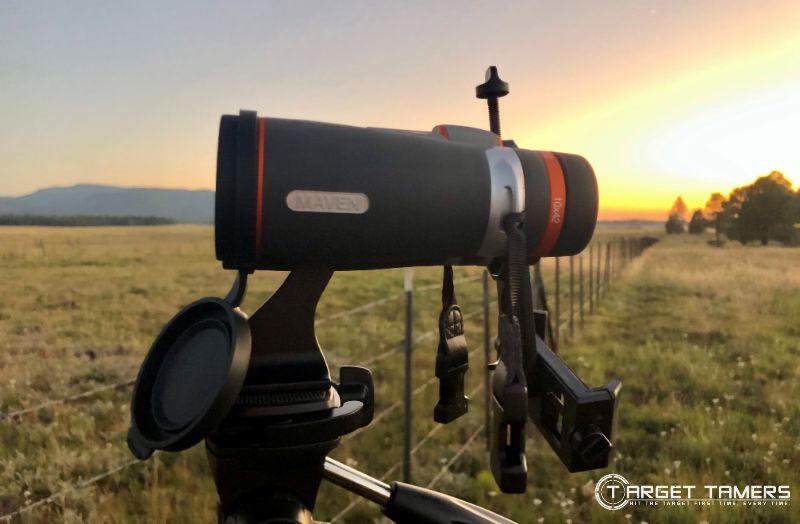
In general, rangefinder binoculars are known to be heavier and larger than their non-ranging counterparts. On average, they'll weigh in between 30-40 oz and will be around 6-8" in length. This is typical of a 10x42 configuration, so they can get bulkier with larger configurations.
Not all ranging binos can be mounted to a tripod. Typically, where the tripod receiver would be, this is now the compartment for the CR2 battery.
Given the weight and size of some ranging binos, a tripod receiver may be a must-have for you. I certainly find value in it even if I don't use it all time. The fact that I can makes all the difference.
| Binocular | Dimensions | Weight | Tripod Receiver |
|---|---|---|---|
| Leica Geovid 3200.com | 7” L | 34.5 oz | Yes |
| Vortex Fury HD 5000AB | 5.8 x 5” | 32.4 oz | Yes |
| Bushnell Fusion X | 7” L | 35 oz | No |
| Swarovski EL Range | 6.6 x 5.3 x 3.1” | 32.6 oz | Yes |
| Steiner Predator LRF | 8.27 x 5.5 x 2.2” | 35.8 oz | No |
| Zeiss Victory RF | 6.5” L | 33.9 oz | No |
| Meopta Optika LR | 6.1 x 5.4 x 2.7” | 32.6 oz | Yes |
| Athlon Cronus UHD | 7.75 x 7 x 3.5” | 38 oz | No |
| ATN Binox 4K | 9.4 x 5 x 2.6” | 40 oz | Yes |
Battery Type & Battery Life

Overall, rangefinder binoculars take the same battery type as a laser rangefinder, the 3V CR2. It powers the lasing engine and the illumination. Without power, you will not see a ranging display. When the batteries fail, you are left with only binocular benefits.
Battery life is measured not by hours but by actuations - how many times you hit the fire/actuator button. This provides only a general idea of battery life because there can be many things that affect it. This includes the illumination setting, scan mode, constant use of the menu and settings, etc.
As you can see, some manufacturers do not disclose an actuation estimate. It's best to keep at least one spare CR2 with your gear when out in the field.
Additionally, when using the ranging bino, make sure you can see the illumination. I once was left without a LRF in the field because I thought the battery died and did not have a spare. When lowlight came around, I found that I just couldn't see the illumination because I last had it on its dimmest settings. It wasn't the battery. Don't be me. Learn from me.
| Binocular | Battery Type | Actuations |
|---|---|---|
| Leica Geovid 3200.com | CR2 | 2000 |
| Vortex Fury HD 5000AB | CR2 | 4000 |
| Bushnell Fusion X | CR2 | Unknown |
| Swarovski EL Range | CR2 | 2000 |
| Steiner Predator LRF | CR2 | Unknown |
| Zeiss Victory RF | CR2 | 2500 |
| Meopta Optika LR | CR2 | 1200 |
| Athlon Cronus UHD | CR2 | Unknown |
| ATN Binox 4K | Internal Li-ion | 15+ hours |
Lase and Glass Better!
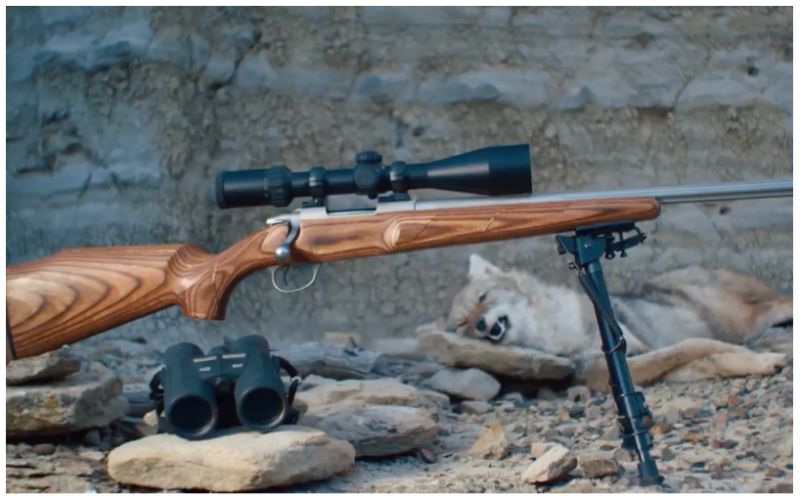
Not everyone needs laser rangefinder and binoculars married into the same optic. But it can't be denied that the streamlined benefits can be extremely helpful to a hunter.
However, there can be compromises to make. They're heavier, rarely come in larger configurations, and they're very expensive.
If you're going to get one, learn how to lase and glass better by knowing what you want out of your glass and how far you can go with the ranging engine.
Further Reading
- 10 Good Reasons to Start Using a Hunting Rangefinder Today
- 10 Tips to Getting the Most Out of Your Hunting Rangefinder
- 10x42 vs 8x42 Binoculars for Hunting, Birding, Safari & Event Observation
- 4 Features to Consider & Look for When Buying Binoculars
- 5 Tips to Maximize Rangefinder Efficiency in Any Light or Weather



